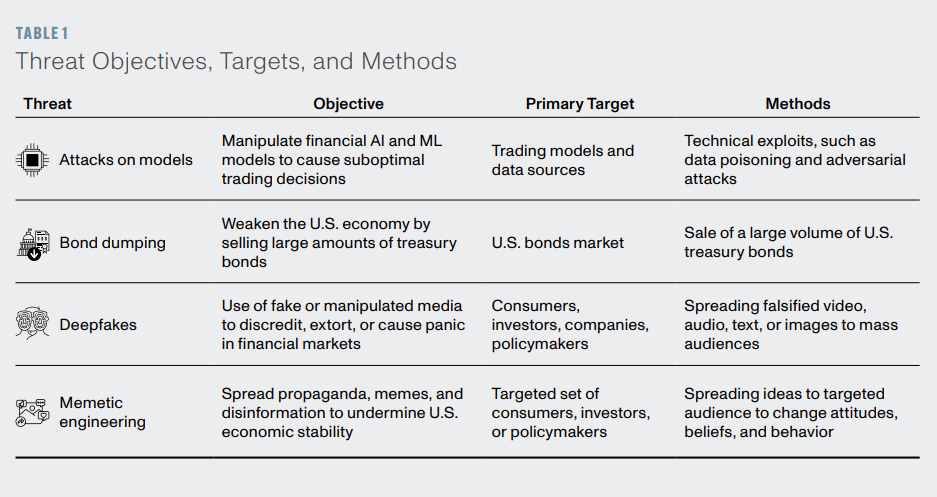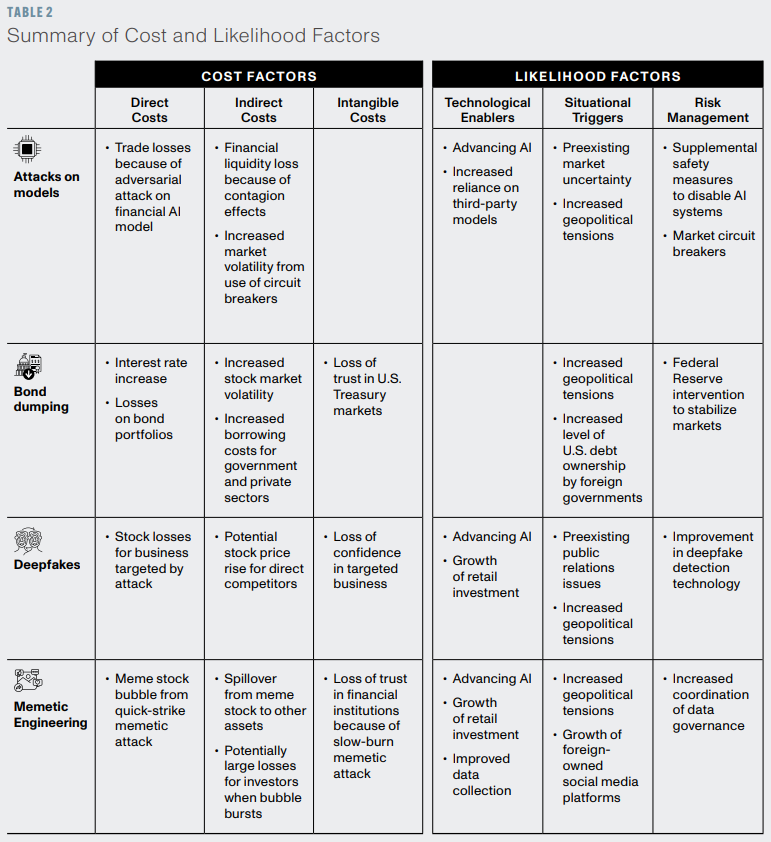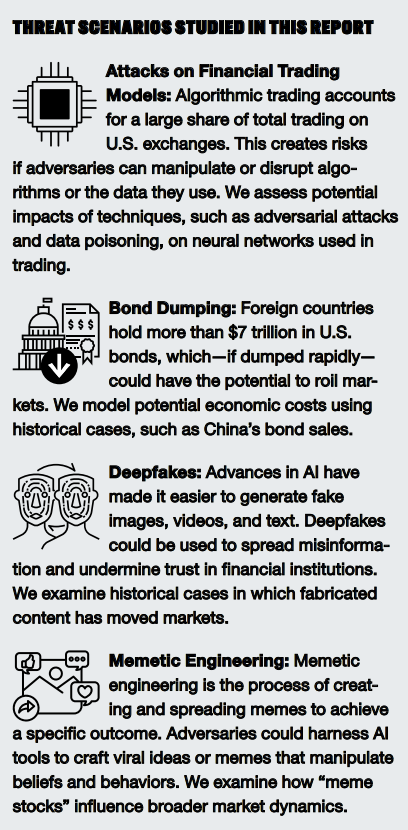This content originally appeared on HackerNoon and was authored by The Sociable
Govts, institutions use the same ‘memetic engineering’ tactics they seek to demonize: perspective
\ Memes are a threat to the US financial system, according to a Pentagon-sponsored report from the RAND Corporation.
\ The RAND report, “Technological and Economic Threats to the US Financial System: An Initial Assessment of Growing Risks” looked at the potential costs and likelihood of four threats to the US financial system:
\
- Attacks on AI-enabled financial trading models
- Bond dumping by foreign holders of US debt
- Using deepfakes to spread misinformation
- Memetic engineering to manipulate beliefs and behaviors
\ Threats from deepfakes and cyberattacks are well-known, and bond dumping has to do with the fact that “foreign countries hold more than $7 trillion in US bonds, which — if dumped rapidly — could have the potential to roll markets.”
\ But memes are a major concern for US defense and intelligence agencies because they can be weaponized to carry out “memetic engineering attacks” that can “manipulate beliefs and behaviors.”
\
“Advanced memetic engineering attacks could progressively undermine trust in financial markets and institutions, causing a steady, incremental impact on market stability rather than a sudden breakdown*“*
RAND Corporation, Technological and Economic Threats to the US Financial System, July 2024
\
\
“Memetic engineering involves designing viral ideas or culture (memes) to achieve a specific psychological or material outcome”
RAND Corporation, Technological and Economic Threats to the US Financial System, July 2024
\ The term “memetic engineering” is “derivative of genetic engineering, with memes being the cultural equivalent of a biological gene.”
\ According to the report, “Memetic engineering involves the strategic creation or manipulation of ideas, concepts, or beliefs to influence a targeted audience, often relying on psychological triggers or cognitive biases.”
\ “It is a more targeted attack than a deepfake attack and can be tailored to specific individuals or groups based on their position within social and economic networks.”
\ These so-called “memetic engineered attacks” can either hit financial institutions quickly to cause a rapid frenzy over a specific set of stocks, or slowly to degrade confidence in the market or financial institutions over time.
\
“The threat of memetic engineering used to degrade trust in markets, institutions, or regulators is a growing concern”
RAND Corporation, Technological and Economic Threats to the US Financial System, July 2024
\ Memes can encapsulate entire narratives in both honest and deceptive ways, sometimes simultaneously.
While memes can be direct, nuanced, or ambiguous, they can also convey truths in subtle ways that can awaken people to new and complex concepts in an easily digestible way.
\ However, it is the power of memes to shift perspectives and challenge official narratives is what worries defense and intelligence agencies.
\ As the RAND report observes, “Potent memes can shape what issues people focus on, who they see as part of their in-group, and how they direct their energy and anger.”
\ But can’t the same be said about official narratives and stories coming from the media, governments, and corporations?
Do authoritative sources not use memetic engineering (narrative control) tactics for the exact same ends — to shape what issues people focus on and to divide the people along partisan and ideological lines?
\
“When weaponized, memes can tap into human tribalism, emotions, cognitive biases, and identity and potentially manipulate behavior or beliefs”
RAND Corporation, Technological and Economic Threats to the US Financial System, July 2024
\
\
“Several experts offered recent events, such as the collapse of Silicon Valley Bank (SVB) and the GameStop short squeeze, as evidence that social media is likely to play a role in propagating deepfakes and memetic engineering attacks into the financial sector”
RAND Corporation, Technological and Economic Threats to the US Financial System, July 2024
\ In a financial setting, the RAND report says that there are likely two potential use cases of memetic engineering:
\
- A quick strike attack aimed at creating a rapid frenzy over a specific set of stocks
- A longer-term degradation of beliefs, ideologies, or confidence in the market or financial institutions
\ The authors conclude that across the board the most significant threat is the longer-term degradation of confidence in institutions.
They liken it to a “financial climate change” narrative because the erosion of confidence happens over time.
\
“The most significant threat is not an abrupt event, akin to a ‘financial 9/11,’ but rather a slow and steady process, akin to ‘financial climate change'”
RAND Corporation, Technological and Economic Threats to the US Financial System, July 2024
\
\ Across the four identified threats, “The most significant threat is not an abrupt event, akin to a ‘financial 9/11,’ but rather a slow and steady process, akin to ‘financial climate change.’
\ “This phenomenon could occur when disinformation or misinformation diminishes public trust in markets, consequently complicating the distinction between reality and fabrication and thereby escalating market volatility,” the report reads.
\ For example, “Advanced memetic engineering attacks could progressively undermine trust in financial markets and institutions, causing a steady, incremental impact on market stability rather than a sudden breakdown.”
\ The RAND authors say that memetic engineering can tap into human tribalism and emotions.
\ At the same time, these “experts” equate financial threats with politically, tribally, and emotionally-charged issues like 9/11 and climate change.
\ They deploy the same memetic engineering tactics they seek to demonize.
\ The RAND report says that “When weaponized, memes can tap into human tribalism, emotions, cognitive biases, and identity and potentially manipulate behavior or beliefs.”
\ Are they not also describing the modus operandi of governments and institutions?
\ After the financial crisis of 2008, the bank bailouts, the printing of trillions of dollars, the crushing inflation, the manipulation of interest rates, the economic sanctions, the war on cash, the introduction of programmable Central Bank Digital Currencies (CBDCs), and the insurmountable debt indicating a potential collapse of the entire financial system as we know it, who wouldn’t question the financial institutions and their regulators?
\ But no, after all of that and more, the government is more worried that memes will undermine trust in financial institutions, rather than the irresponsible actions of those institutions themselves.
\
:::info Tim Hinchliffe, Editor, The Sociable
:::
\
This content originally appeared on HackerNoon and was authored by The Sociable
The Sociable | Sciencx (2024-08-13T13:00:37+00:00) Memes Pose a Threat to the US Financial System: RAND Report. Retrieved from https://www.scien.cx/2024/08/13/memes-pose-a-threat-to-the-us-financial-system-rand-report/
Please log in to upload a file.
There are no updates yet.
Click the Upload button above to add an update.



